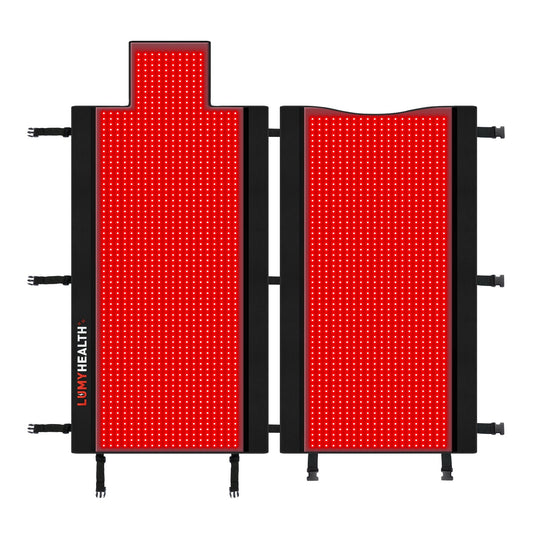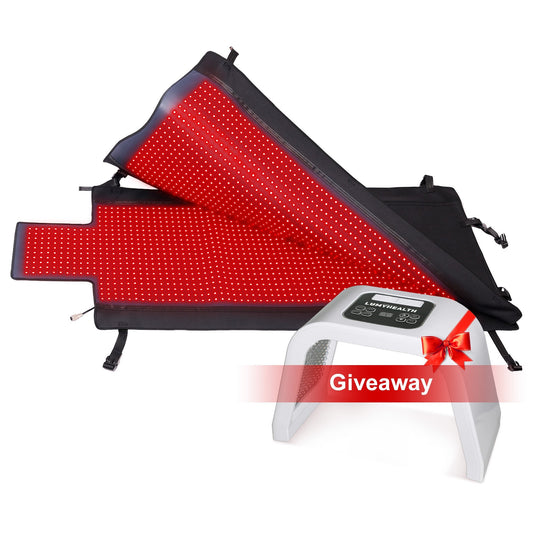Table of Contents
- What Causes Excess Weight?
-
Why is Weight Loss Important?
- Health
- Cosmetic
- What is Red Light Therapy?
- Technology of Red Light Therapy
- Uses of Red Light Therapy
-
Red Light Therapy for Weight Loss
- Overview of Studies
- Using Red Light Therapy for Weight Loss
What Causes Excess Weight?
Excess weight can result from a variety of factors, including genetics, lifestyle choices, health conditions, and environmental influences. At its core, weight gain occurs when the body stores more energy than it uses, typically in the form of fat. The main contributors to this energy imbalance include:
- Excessive calorie consumption: Diets rich in sugars and high-calorie foods can lead to weight gain. The average American consumes much more sugar than the recommended daily intake, contributing to the excess energy stored as fat.
- Insufficient physical activity: A sedentary lifestyle makes it easier for the body to store energy as fat, as there’s little activity to burn those calories.
- Health conditions: Issues like insulin resistance or hypothyroidism can make it harder to lose weight.
Why is Weight Loss Important?
Excess weight can impact health in numerous ways, increasing the risk of chronic conditions like:
- Health: Conditions such as metabolic syndrome, heart disease, and type 2 diabetes are commonly linked to obesity.
- Cosmetic: The societal standards around body image often pressure individuals to maintain a certain weight, despite the complexities of weight loss. Even individuals at a healthy weight may feel the need to conform to social expectations.
Red light therapy for weight loss has emerged as a promising way to assist in managing body weight. While not a substitute for a healthy diet and exercise, red light therapy for weight loss can enhance fat reduction and help improve overall body shape.
What is Red Light Therapy?
Red light therapy for weight loss uses low-level wavelengths of red or near-infrared light to stimulate cells and tissues, improving various health conditions. By penetrating the skin, red light therapy for weight loss targets the mitochondria in cells, enhancing their production of ATP (adenosine triphosphate), the cellular energy necessary for optimal cell function.
Although red light therapy for weight loss is commonly used for skin care, wound healing, and sleep improvement, there’s growing interest in its potential for fat reduction and body sculpting.
If you're looking for high-quality red light therapy for weight loss, check out LumyHealth's red light therapy mats, which are designed to provide effective treatments for fat burning and body sculpting.

Technology of Red Light Therapy
The science behind red light therapy for weight loss involves exposing the skin to specific wavelengths of light that can penetrate deep into tissues. These wavelengths stimulate the mitochondria, which are responsible for producing ATP, and in turn, can influence cellular activities like fat breakdown, collagen production, and inflammation reduction.
Studies have shown that light can have significant physiological effects on the body. For instance:
- Vitamin D synthesis: Exposure to sunlight stimulates the creation of vitamin D in the skin, which has numerous health benefits.
- Melanin production: Sunlight exposure increases melanin production, giving skin a darker tone.
- Bilirubin breakdown: Certain wavelengths of light can break down bilirubin in the body, a substance that can be harmful in excess.
Uses of Red Light Therapy
Red light therapy for weight loss has a broad range of applications, including:
- Improving skin tone and elasticity
- Promoting better sleep
- Enhancing athletic recovery
- Accelerating wound healing
Research continues into new areas of use, with red light therapy for weight loss emerging as an exciting possibility.
If you're interested in trying red light therapy for weight loss, LumyHealth's products are perfect for targeting large areas of the body, allowing you to enhance fat burning and overall wellness.
Red Light Therapy for Weight Loss
Overview of Studies
While the research into red light therapy for weight loss is still in its early stages, there are promising signs. Several studies have explored the potential benefits of RLT in fat reduction:
- A 2020 study on low-level laser therapy (LLLT) showed a slight weight loss (around 2 pounds) and improved body satisfaction among participants.
- A 2013 study focused on using red light therapy for weight loss targeting the waist, hips, and thighs, showing an average reduction of almost 3 inches.
- A more rigorous 2012 study used a double-blind, randomized controlled design and found that after 3 weeks of therapy, participants saw significant reductions in body measurements, particularly around the arms.
Despite these positive outcomes, there’s still no large-scale conclusive evidence on whether red light therapy for weight loss can lead to dramatic weight loss on its own. Instead, it seems more effective as a complementary treatment to improve body contour and enhance fat loss when combined with exercise and a healthy diet.
Using Red Light Therapy for Weight Loss
If you’re considering incorporating red light therapy for weight loss into your routine, it’s important to understand how to use it effectively:
- Choose the right device: Look for devices that provide the appropriate wavelengths and power to stimulate fat cells.
- Follow usage guidelines: Typically, sessions last 10–20 minutes per area, several times a week.
- Be consistent: Consistency is key to seeing results. Combine therapy with a healthy lifestyle for the best effects.
- Monitor progress: Track how your body responds to red light therapy for weight loss, adjusting as needed.
LumyHealth’s red light therapy mats are designed to offer reliable, effective treatments, helping you achieve your body goals and improve your overall health.
Sources and References
- Karu, T. (2013). "The Science of Low-Level Light Therapy." Journal of Photochemistry and Photobiology.
- Chaves, M. E., & Soriano, R. A. (2016). "Effects of Low-Level Light Therapy on Fat Reduction." International Journal of Obesity.
- PubMed. "Photobiomodulation and Weight Loss: A Review." National Institutes of Health.

































